
Types of Synthetic Running Track
There are a number of different synthetic surfacing system types available for athletics. Most of these systems are offered by a considerable number of different manufacturers and installers. It therefore follows that the number of surfacing products is very large. All synthetic surfaces rely on a good standard of base construction, which is an essential pre-requisite for the successful installation of the surface and for its long-term performance.
There are several sub-divisions of synthetic surface type. Some systems are prefabricated in the factory and delivered to site as rolls of material which are adhesive bonded to the base (See Picture 1). Others are composites of these two systems. Each type has certain advantages and disadvantages.
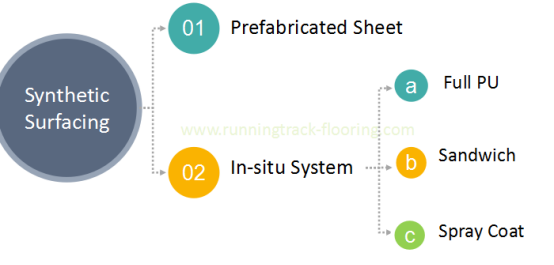
These products comprise a principal layer of polyurethane resin-bound rubber crumb, finished with a texturised surface coating of polyurethane paint. The crumb is mixed with a one-component moisture-curing polyurethane resin in the correct proportions.
Key Points
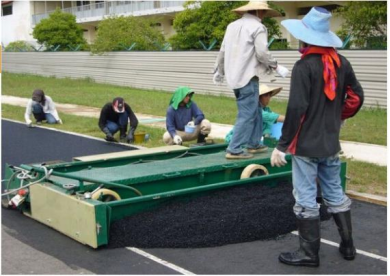
Pic. 5
Reference
There are several sub-divisions of synthetic surface type. Some systems are prefabricated in the factory and delivered to site as rolls of material which are adhesive bonded to the base (See Picture 1). Others are composites of these two systems. Each type has certain advantages and disadvantages.

Pic. 1
01 Prefabricated Sheet
This type of system is made from a rubber compound, processed by calendaring followed by curing and rolling. The material will obviously conform to any contours and irregularities in the base to which it is bonded. It is therefore vitally important that the base fully conforms to the stipulated shallow gradients and levels requirements in order to avoid the formation of standing water.
Key Points 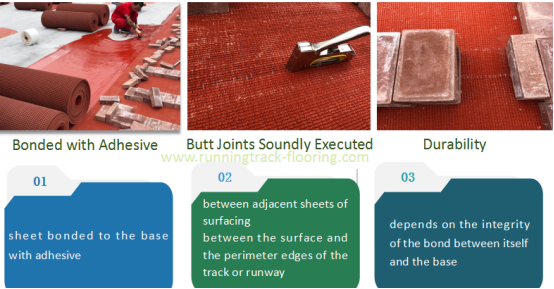
02 In-situ System
The other main group of surfacing systems, comprises those products which are fabricated on site from their raw materials. The majority of outdoor tracks is surfaced
with these systems. These may be sub-divided into three principal types: cast elastomers (Full PU Running Track), composite systems (Sandwich Running Track) and resin-bound rubber crumb (Spray Coat Running Track).
02.1 Full PU Type
These products are laid as free-flowing liquid polyurethane. The cast polyurethane resin is prepared by mixing two components, one a liquid polyol and the other an
isocyanate in the correct proportions.
Key Points
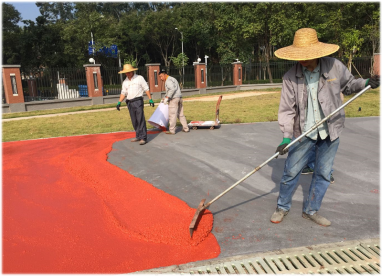
Pic. 3
02.3 Spray Coat TypeThis type of system is made from a rubber compound, processed by calendaring followed by curing and rolling. The material will obviously conform to any contours and irregularities in the base to which it is bonded. It is therefore vitally important that the base fully conforms to the stipulated shallow gradients and levels requirements in order to avoid the formation of standing water.
Key Points
- non-porous and has an embossed or textured surface finish
- produced in the controlled conditions of a factory, thickness of the sheet can be controlled accurately, uniform performance properties
- the roll sheets are bonded to the base with adhesive

Pic. 2
02 In-situ System
The other main group of surfacing systems, comprises those products which are fabricated on site from their raw materials. The majority of outdoor tracks is surfaced
with these systems. These may be sub-divided into three principal types: cast elastomers (Full PU Running Track), composite systems (Sandwich Running Track) and resin-bound rubber crumb (Spray Coat Running Track).
02.1 Full PU Type
These products are laid as free-flowing liquid polyurethane. The cast polyurethane resin is prepared by mixing two components, one a liquid polyol and the other an
isocyanate in the correct proportions.
Key Points
- Laid as free-flowing liquid polyurethane
- Polyurethane resin is prepared by mixing two components
- Resin mixed of chopped rubber crumb to give a viscous liquid compound spread on to the base of the track
- Colored EPDM rubber granules sprayed or spread onto the surface

Pic. 3
02.2 Sandwich Type
Sandwich systems are a hybrid of the cast elastomer and the resin-bound rubber crumb products. They are sometimes known as "double-decker" systems. They are formed from a base mat of resin-bound rubber crumb, typically about 9mm in thickness. After cure, the open textured mat is grouted with a very fine rubber crumb, and then a cast elastomer layer is applied as the top surface.
Key Points
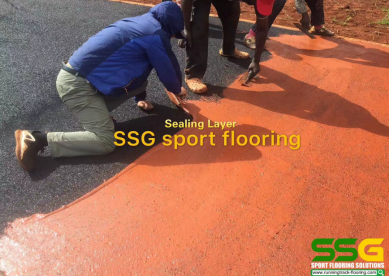
Pic. 4
Sandwich systems are a hybrid of the cast elastomer and the resin-bound rubber crumb products. They are sometimes known as "double-decker" systems. They are formed from a base mat of resin-bound rubber crumb, typically about 9mm in thickness. After cure, the open textured mat is grouted with a very fine rubber crumb, and then a cast elastomer layer is applied as the top surface.
Key Points
- Formed from a base mat of resin-bound rubber crumb
- After cure, the open textured mat is grouted with two component PU resin
- And then a viscous liquid compound of resin and EPDM granules is sprayed or spread on to the surface

Pic. 4
These products comprise a principal layer of polyurethane resin-bound rubber crumb, finished with a texturised surface coating of polyurethane paint. The crumb is mixed with a one-component moisture-curing polyurethane resin in the correct proportions.
Key Points
- Comprise a principal layer of polyurethane resin-bound rubber crumb
- The crumb is mixed with a one-component moisture-curing polyurethane
- coloured polyurethane paint containing a fine rubber aggregate is sprayed on to rubber base mat

Pic. 5
Reference
Wilson, Denis, et al., (2008). IAAF Track and Filed Facilities Manual (pp 87-94). Monaco: Editions EDC.






Leave a comment